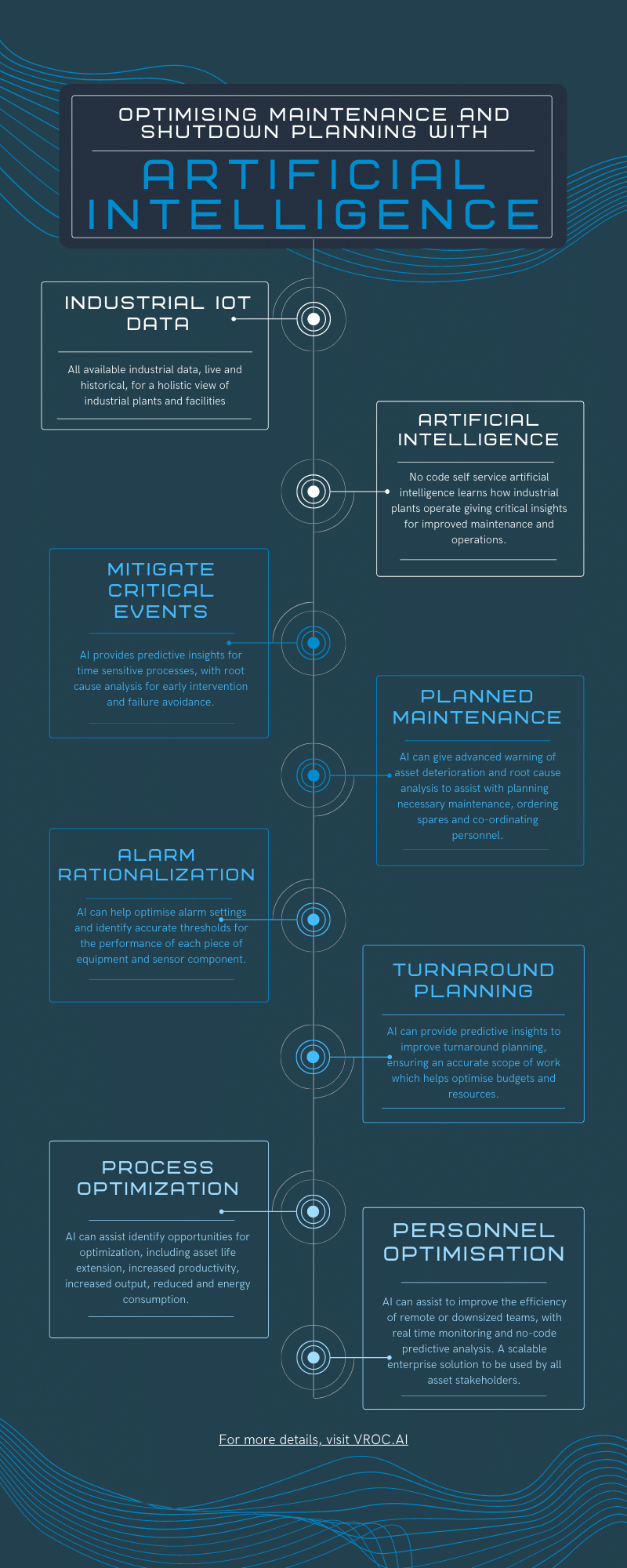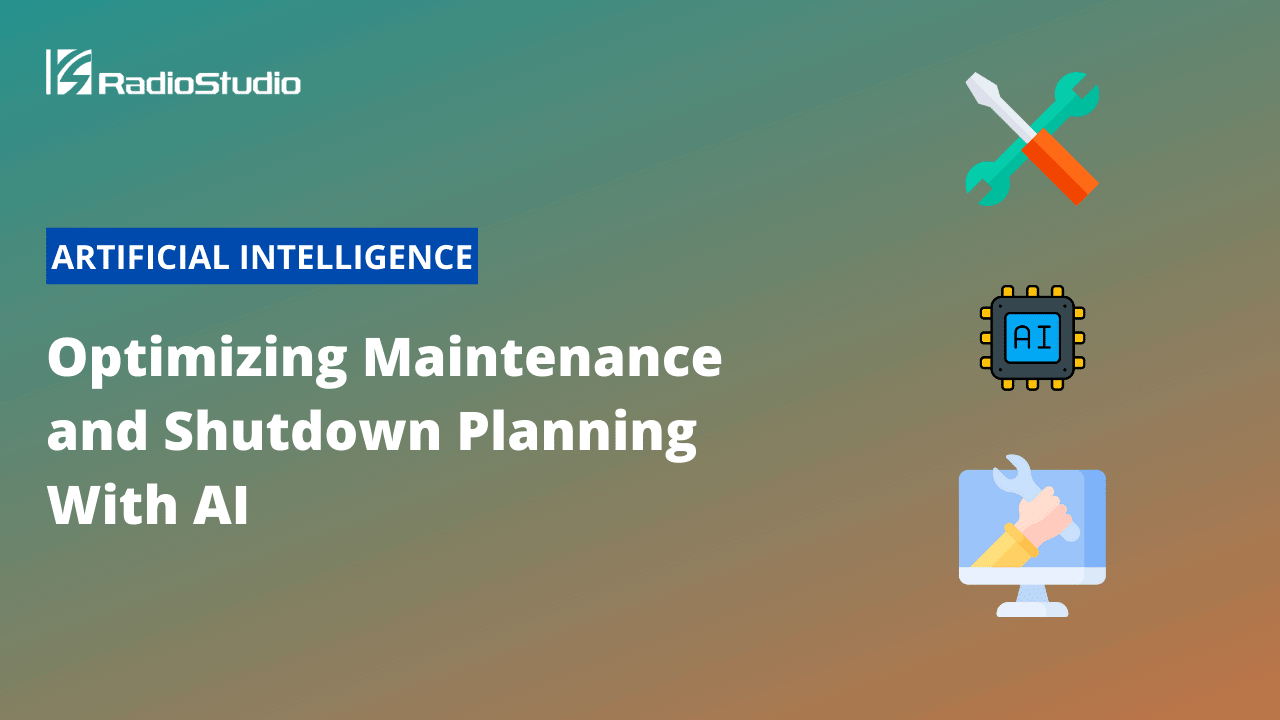Maintenance planning is a critical step to contain downtime, planned or unplanned, which can cost hundreds of thousands of dollars in lost production per hour. Artificial intelligence provides critical insights for improved maintenance and shutdown planning, increasing the reliability of industrial facilities, and reducing operational costs. In this article we explore how big data and artificial intelligence (AI) can be used as a tool to help industries optimise maintenance and shutdown planning and execution.
This article was originally published by VROC.
Avoiding Unplanned Shutdowns With AI
Artificial intelligence can make detections between seemingly unrelated processes. Often it is these unrelated processes that can catch operators, engineers, and maintenance personnel off-guard, and lead to unplanned shutdowns. Determining the root cause can sometimes prove difficult and even if engineers can detect a system is deviating, if they do not know the cause, it is extremely hard to mitigate the problem.

A major unplanned shutdown and significant safety incident was avoided by one of VROC’s customers when the AI model detected the root cause of a potential gas leak from a separate process. The engineering team acted on the AI insights, the situation was quickly brought under control, and they avoided a major incident. The customer confirmed the incident avoidance was valued at close to One Million USD.
Optimizing Planned Maintenance With AI
Not all maintenance needs to be done during a site shutdown, as some processes can be shut down in isolation to allow for critical maintenance and repairs. These maintenance windows require careful planning, the ordering of spare parts and co-ordination of personnel.
With plants situated in remote areas, the reduction of personnel on site and the prevalence of remote working, the intelligent planning of maintenance is essential. Advanced notification of required maintenance with identified root causes allows companies time to plan and prepare.
Artificial intelligence is helping many companies stay on top of their critical maintenance, even during the COVID-19 pandemic. Having advanced visibility, enabled one operator in the North Sea to not only maintain their production levels, but were also able to improve their overall efficiency, despite reduced personnel on board and remote engineering teams.
Instead of waiting for thresholds to be met or exceeded, which is typical for condition monitoring systems, artificial intelligence continually looks for a deviation and provides advance warning. In a situation where a failure cannot be mitigated, sufficient lead time can be provided for predictive maintenance. This allows an operator to switch to a back-up, bring a back-up online, or decide to shutdown half of a process train, thereby keeping production going, even if only at half capacity. This is always a preferred solution as any sudden unplanned event has increased safety and environmental risks, along with lost productivity.
AI for Turnaround Planning
Process industries are always planning their next turnaround (TAR) event. During a turnaround, production in the whole facility comes to a stop as asset maintenance, refurbishment, life extension and renovations take place.
The window to perform maintenance across a whole facility needs to be carefully planned. A risk analysis is performed to determine the scope of the work to be undertaken during a turnaround based on criticality and integrity, safety and commercial factors. This planning considers the original equipment manufacturer requirements, warranty requirements, current performance, reliability and most significantly the company’s medium to long term strategic plans.
With turnarounds taking weeks or sometimes months to complete, companies try to extend the amount of time between required maintenance shutdowns.
The use of industrial big data and artificial intelligence is helping industry gain greater insights into how equipment is operating and performing. AI can help detect the most minute degradation in equipment and predict the trend of continued degradation right up to failure or breakdown. The degradation may be unnoticeable now, but if it is going to cause a failure in 6 months’ time, you may decide to plan its repair in your upcoming turnaround event, or even bring the turnaround forward based on the level of deterioration and criticality of the asset or process.
Quite often, the planned scope of work may not be necessary for the current turnaround, as AI may reveal that the equipment is functioning optimally with no predictions for deviations or major degradation over time. This insight helps to optimize turnaround budgets, resources, and ensures that priority is given to the tasks that will yield the most benefit.
With AI predictions and insights, companies can respond more dynamically to current and future conditions and can optimize their turnaround planning.
AI for Alarm Rationalization
Alarm Rationalization has become critical in highlighting important alarms while suppressing bad actors to allow panel operators to focus on critical process faults. The AOA (Alarm Objective Analysis) workshops typically require several days with all asset stakeholders ranging from O&M personnel to engineering and reliability experts to review, validate and justify the alarms and their settings to ensure the safety of a process. This is an expensive activity which artificial intelligence can help to optimize.
When we apply AI to your entire industrial plants live and historic data, it learns how your system operates under all different operating conditions and discovers what optimum performance and failure look like. AI can help optimize alarm settings and identify accurate thresholds for the performance of each piece of equipment and sensor component.
The alarms can then be put straight into operation, with alerts set in the live operating environment. Operators can select who is notified for each alert and the escalation process
Trusting AI
Optimizing shutdowns and maintenance planning with artificial intelligence involves an evolution in maintenance methodology. However, the beauty of industrial AI is that it is not such a ‘leap of faith’ as some fear, in fact it is quite the opposite. The volume of data being analyzed in real time, gives engineers the ability to drill down into the data at a granular level. Typically, there are multiple indicators to a prediction and the artificial intelligence model provides a confidence level for its accuracy. The advance notifications provide operations and maintenance teams the time to further investigate the predictions and determine their accuracy independently, as well as potentially run other AI models in parallel to test theories and predictions. Models can be created in minutes allowing confidence to develop within teams who may not have previously used artificial intelligence for maintenance planning.
When it comes to digitally transforming how we approach maintenance and shutdowns, artificial intelligence is a key tool. Intelligent data insights will help optimise how we plan our maintenance expenditure and resources, and lead to more productive and reliable industrial processes with reduced OPEX.


